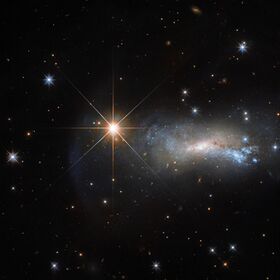Astronomy:NGC 7250
From HandWiki
Short description: Irregular galaxy in the constellation Lacerta
Coordinates: ![]() 22h 18m 17.776s, +40° 33′ 44.66″
22h 18m 17.776s, +40° 33′ 44.66″
| NGC 7250 | |
|---|---|
 NGC 7250, as taken by the Hubble Space Telescope[1] | |
| Observation data (J2000 epoch) | |
| Constellation | Lacerta[1] |
| Right ascension | 22h 18m 17.776s[2] |
| Declination | +40° 33′ 44.66″[2] |
| Redshift | 0.0039[3] |
| Helio radial velocity | 1,168 km/s[3] |
| Distance | 49.99 ± 14.37 Mly (15.328 ± 4.407 Mpc)[4] |
| Apparent magnitude (V) | 12.58[3] |
| Apparent magnitude (B) | 13.22[3] |
| Characteristics | |
| Type | Irr |
| Mass | 4.7×108[5] M☉ |
| Other designations | |
| PGC 68535, UGC 11980, MCG+07-45-024, Mrk 907, Z 530-22 | |
NGC 7250 is an irregular galaxy located in the Lacerta constellation. It is a blue-colored galaxy with bright bursts of star formation: its star-forming rate is more than an order of magnitude greater than that of the Milky Way.[5]
In 2013, a type Ia supernova was detected within the galaxy, and was designated SN 2013dy. It was detected about 2.4 hours after the explosion, making it the earliest-known detection of a supernova at the time.[6]
The brighter star located in front of the galaxy is named TYC 3203-450-1, and is barely studied. It is about a million times closer to Earth than it the galaxy itself.[7]
References
- ↑ 1.0 1.1 "A matter of distance". https://www.spacetelescope.org/images/potw1717a/.
- ↑ 2.0 2.1 Skrutskie, Michael F.; Cutri, Roc M.; Stiening, Rae; Weinberg, Martin D.; Schneider, Stephen E.; Carpenter, John M.; Beichman, Charles A.; Capps, Richard W. et al. (1 February 2006). "The Two Micron All Sky Survey (2MASS)". The Astronomical Journal 131 (2): 1163–1183. doi:10.1086/498708. ISSN 0004-6256. Bibcode: 2006AJ....131.1163S.
- ↑ 3.0 3.1 3.2 3.3 "NGC 7250". SIMBAD. Centre de données astronomiques de Strasbourg. http://simbad.u-strasbg.fr/simbad/sim-basic?Ident=NGC+7250.
- ↑ "NED results for object NGC 7250". National Aeronautics and Space Administration / Infrared Processing and Analysis Center. http://nedwww.ipac.caltech.edu/cgi-bin/nph-objsearch?objname=NGC+7250&extend=no&out_csys=Equatorial&out_equinox=J2000.0&obj_sort=RA+or+Longitude&of=pre_text&zv_breaker=30000.0&list_limit=5&img_stamp=YES.
- ↑ 5.0 5.1 Pan, Y.-C.; Foley, R. J.; Kromer, M.; Fox, O. D.; Zheng, W.; Challis, P.; Clubb, K. I.; Filippenko, A. V. et al. (2015). "500 days of SN 2013dy: Spectra and photometry from the ultraviolet to the infrared". Monthly Notices of the Royal Astronomical Society 452 (4): 4307. doi:10.1093/mnras/stv1605. Bibcode: 2015MNRAS.452.4307P.
- ↑ Zheng, Weikang; Silverman, Jeffrey M.; Filippenko, Alexei V.; Kasen, Daniel; Nugent, Peter E.; Graham, Melissa; Wang, Xiaofeng; Valenti, Stefano et al. (2013). "THE VERY YOUNG TYPE Ia SUPERNOVA 2013dy: DISCOVERY, AND STRONG CARBON ABSORPTION IN EARLY-TIME SPECTRA". The Astrophysical Journal 778 (1): L15. doi:10.1088/2041-8205/778/1/L15. Bibcode: 2013ApJ...778L..15Z.
- ↑ Hille, Karl (2017-04-28). "Hubble's Bright Shining Lizard Star" (in en). NASA. https://www.nasa.gov/image-feature/goddard/2017/hubbles-bright-shining-lizard-star.
External links
 |

